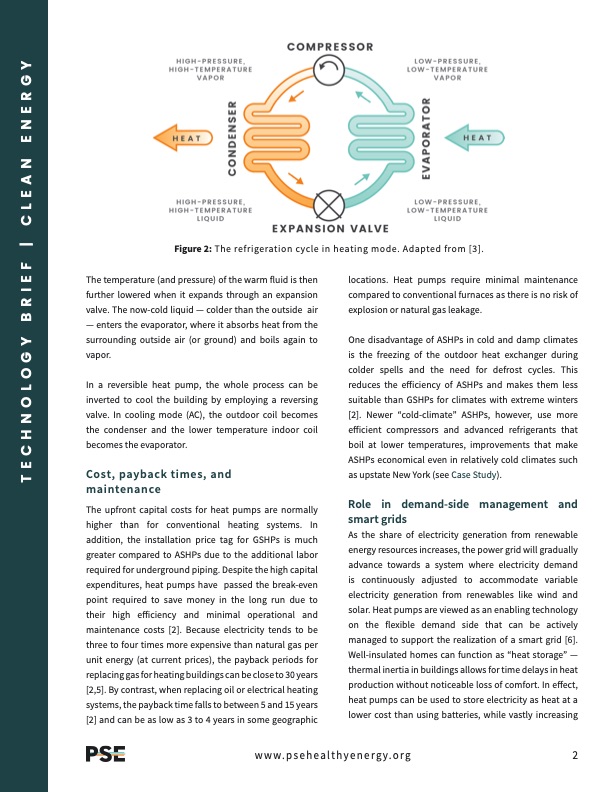
PDF Publication Title:
Text from PDF Page: 002
Figure 2: The refrigeration cycle The temperature (and pressure) of the warm fluid is then further lowered when it expands through an expansion valve. The now-cold liquid — colder than the outside air — enters the evaporator, where it absorbs heat from the surrounding outside air (or ground) and boils again to vapor. In a reversible heat pump, the whole process can be inverted to cool the building by employing a reversing valve. In cooling mode (AC), the outdoor coil becomes the condenser and the lower temperature indoor coil becomes the evaporator. Cost, payback times, and maintenance The upfront capital costs for heat pumps are normally higher than for conventional heating systems. In addition, the installation price tag for GSHPs is much greater compared to ASHPs due to the additional labor required for underground piping. Despite the high capital expenditures, heat pumps have passed the break-even point required to save money in the long run due to their high efficiency and minimal operational and maintenance costs [2]. Because electricity tends to be three to four times more expensive than natural gas per unit energy (at current prices), the payback periods for replacing gas for heating buildings can be close to 30 years [2,5]. By contrast, when replacing oil or electrical heating systems, the payback time falls to between 5 and 15 years [2] and can be as low as 3 to 4 years in some geographic in heating mode. Adapted from [3]. locations. Heat pumps require minimal maintenance compared to conventional furnaces as there is no risk of explosion or natural gas leakage. One disadvantage of ASHPs in cold and damp climates is the freezing of the outdoor heat exchanger during colder spells and the need for defrost cycles. This reduces the efficiency of ASHPs and makes them less suitable than GSHPs for climates with extreme winters [2]. Newer “cold-climate” ASHPs, however, use more efficient compressors and advanced refrigerants that boil at lower temperatures, improvements that make ASHPs economical even in relatively cold climates such as upstate New York (see Case Study). Role in demand-side management and smart grids As the share of electricity generation from renewable energy resources increases, the power grid will gradually advance towards a system where electricity demand is continuously adjusted to accommodate variable electricity generation from renewables like wind and solar. Heat pumps are viewed as an enabling technology on the flexible demand side that can be actively managed to support the realization of a smart grid [6]. Well-insulated homes can function as “heat storage” — thermal inertia in buildings allows for time delays in heat production without noticeable loss of comfort. In effect, heat pumps can be used to store electricity as heat at a lower cost than using batteries, while vastly increasing www.psehealthyenergy.org 2 TECHNOLOGY BRIEF | CLEAN ENERGYPDF Image | Lync heat pump diagram

PDF Search Title:
Lync heat pump diagramOriginal File Name Searched:
HeatPumps.pdfDIY PDF Search: Google It | Yahoo | Bing
CO2 Organic Rankine Cycle Experimenter Platform The supercritical CO2 phase change system is both a heat pump and organic rankine cycle which can be used for those purposes and as a supercritical extractor for advanced subcritical and supercritical extraction technology. Uses include producing nanoparticles, precious metal CO2 extraction, lithium battery recycling, and other applications... More Info
Heat Pumps CO2 ORC Heat Pump System Platform More Info
| CONTACT TEL: 608-238-6001 Email: greg@infinityturbine.com | RSS | AMP |